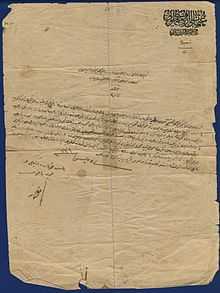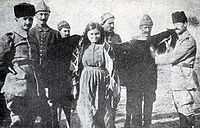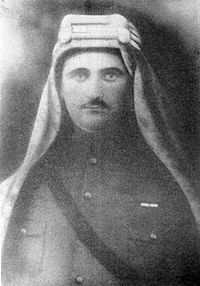Sarkis Torossian
| Sarkis Torossian | |
|---|---|
|
Torossian as commander of Arab forces in Damascus during World War I | |
| Born |
1891 Everek (present-day: Develi), Ottoman Empire |
| Died |
October 17, 1954 (aged 63) Bronx, New York |
Resting place | Arlington Cemetery, Drexel Hill, Pennsylvania |
| Nationality | Ottoman |
| Ethnicity | Armenian |
Sarkis Torossian (Turkish: Sarkis Torosyan, 1891 - August 17, 1954) was a decorated Ottoman captain of Armenian descent who fought in the Gallipoli Campaign and according to his memoirs, was the first person to sink a British battleship.[1][2][3] After the Armenian Genocide however, when most of his family was massacred, he switched sides and joined the fight against Ottoman Empire.[2][3][4] He later moved to the United States where he wrote and published his memoirs, From Dardanelles to Palestine: a true story of five battle fronts of Turkey. His story has led to a debate in Turkey where Turkish historians have discredited the authenticity of his memoirs and with some historians claiming he never existed.[5][6] In anticipation of the publication of Torosian's memoirs in Turkey by Ayhan Aktar, Torosian's descendants were discovered by local historian Paul Vartan Sookiasian. From there, Taner Akçam interviewed Torosian's granddaughter who described in detail about her grandfather's life.[7]
Life
Sarkis Torossian was born in the Armenian populated village of Everek (present-day: Develi) near Kayseri in 1893. He attended the local Armenian Parochial School. At an early age, Sarkis Torossian wanted to become a soldier, however Ottoman Turkish law forbid any non-Muslim to become soldiers until the Young Turk Revolution in 1908.[8] Torossian continued his education in Edirne where he befriended an Arab named Muharrem whose father was a Brigadier General in Constantinople.[2] Through the help of Muharrem's father, Torossian was secured a position in the Military College and graduated in 1914 with the rank of Second Lieutenant of the Artillery.[2] During his frequent visits to his father, Torossian began to develop a passion for his daughter (Muharrem's sister) Jemileh.[2]
Gallipoli Campaign

Upon graduation of the military academy, Torossian was sent to Germany, to the Krups factory, where he remained for three months.[1] After the start of World War I, Torossian returned to Ottoman Empire where he was appointed to commander of Cape Helles.[1] Early in 1915 when the battle of Gallipoli Campaign was in its early stages, Torossian sunk the first British battleship.[2] In his memoirs, Sarkis Torossian also claimed that he sunk a total of three English battle cruisers in the fighting between February 19 and March 18 as well as one submarine in April, which might possibly have been, according to him, the HMS E15 of the British Royal Navy.[1] Cevat Pasha praised Torossian's efforts in the battle and pointed out that the forts under his command were the most effective in sinking British ships.[1][2] When Minister of War Enver Pasha heard of Torossian's deeds during the battle, he congratulated him and introduced him to high ranking German officers such as Colmar Freiherr von der Goltz and Liman von Sanders.[1] Enver Pasha also awarded Torossian with Osmanlı Devleti harp madalyası (Ottoman State War Medal).[9] In the morning of September 29, 1915, Torossian received word that Muharrem was gravely injured during battle and rushed to see him. Just before Muharrem died, he made a confession about his sister Jemileh. According to Torossian's diary The confession is written in his diary as follows:[1][2]
| “ | During the Armenian massacres of 1896 my father was commander of an army brigade stationed near Mush. Even at that time he was deeply aggrieved over Turkish excesses in dealing with their Christian subjects. One day, while passing through an Armenian village, he picked up a little girl, hardly more than two years old, whom he found wandering aimlessly about the deserted streets. No trace of her parents was found, and out of pity, or love, or sorrow my father took her home with him. Eventually she was accepted into the family. My mother, however, objected to a cross tattooed on her upper left arm and applied an acid solution to destroy the Christian emblem; it left a queer shaped scar. | ” |
After hearing the confession, Muharrem had made it clear that he would like Torossian to marry his sister. Sarkis Torossian engages with Jemileh soon thereafter.[1]
Armenian Genocide
During the initial stages of the Armenian Genocide when Armenians were forced to be deported, Sarkis Torossian received assurances from Enver Pasha that his family will not be deported.[1][10] However, the governor of the Kayseri province Salih Zeki Bey, ignored Enver Pasha orders and continued with the deportation of Torossian's family.[10][11] Torossian's father Ohannes and mother Vartuhi were murdered and only his sister Bayzar survived.[10] To save his sister, Torossian went to Macedonia then Romania and finally to the Arabian deserts where he successfully found his sister in the Tel Halaf concentration camp.[1][2][10] Soon thereafter, however, both his sister Bayzar and Jemileh died from diseases.[1][2][10]

Jemileh happened to die in his arms and is quoted in the memoirs as saying, "I raised Jemileh in my arms, the pain and terror in her eyes melted until they were bright as stars again, stars in an oriental night...and so she died, as a dream passing".[1][3][12] Upon hearing the stories of his sister and having lost his father, mother, sister, and fiancée, Torossian vowed for "revenge" against the Turkish government.[1][2][3][10][11]
Arab Campaign
In September 1918, during the Battle of Nablus, Sarkis Torossian joins the British and fights along with Arab rebels against the Ottoman Army.[3][10] In his memoirs, Torossian writes "I wanted to break the waist of the Turkish Army".[1][3][10] Sarkis Torossian soon led a platoon of Arab soldiers in Palestine and was in charge of 6,000 Arab horsemen in Damascus. For his bravery and leadership in Palestine, the British bestowed him with medals.[2]
French Armenian Legion
The French Armenian Legion, established with the French-Armenian Agreement of 1916, was a foreign legion unit within French Army. The Armenian legion was established under the goals of the Armenian national liberation movement and was an armed unit besides the Armenian volunteer units and Armenian militia during World War I which fought against the Ottoman Empire. Sarkis Torossian used the opportunity of the French Armenian Legions to fight against the Turkish army.[12] The Turkish guerrillas under the leadership of Mustafa Kemal forces pushed back much of the French and Armenian forces in Cilicia and gain control of the region. Torossian suspects in his diary that the French forces gave weapons and ammunition to the Kemalists to allow the French army safe passage out of Cilicia.[12] Having felt betrayed, Torossian emigrated to the United States where he met his relatives. The French however decorated Torossian with medals as well.[2]
Later Life in America
Sarkis Torossian emigrated to Philadelphia. In 1927, he published his memoirs in Boston called From Dardanelles to Palestine: a true story of five battle fronts of Turkey which describes his life and achievements in detail. His memoir has been used by historians to further analyze and research about World War I and the Armenian Genocide. Sarkis Torossian died on October 17, 1954 in Bronx, New York at the age of 63 and is buried at the Arlington Cemetery in Drexel Hill, Pennsylvania.[4]
Legacy
According to author Ayhan Aktar, who edited and published Torossian's memoirs into Turkish, the Turkish official history erased Torossian's name from records and ignored his successes in the Gallipoli Campaign due to his Armenian origin.[3][11]
References
- ↑ 1.0 1.1 1.2 1.3 1.4 1.5 1.6 1.7 1.8 1.9 1.10 1.11 1.12 1.13 Torossian, Sarkis (1947). From Dardanelles to Palestine: a true story of five battle fronts of Turkey and her allies and a harem romance (PERSONAL MEMOIRS). Boston: Meador Pub. Co. p. 219.
- ↑ 2.0 2.1 2.2 2.3 2.4 2.5 2.6 2.7 2.8 2.9 2.10 2.11 2.12 "Sarkis Torossian: an Armenian hero of Dardanelle". Armenian Genocide Museum. Retrieved 2 January 2013.
- ↑ 3.0 3.1 3.2 3.3 3.4 3.5 3.6 Aktar, Ayhan (2012). Yüzbaşı Sarkis Torosyan – Çanakkale’den Filistin Cephesi’ne (in Turkish). Istanbul: İletişim Yayınları. Retrieved 2 January 2013.
- ↑ 4.0 4.1 "Sarkis Torosian". Findagrave. Retrieved 2 January 2013.
- ↑ "Robert Fisk: The Armenian hero whom Turkey would prefer to forget - Comment - Voices - The Independent". The Independent.
- ↑ "Sarkis Torossian Debate". Taner Akçam. Retrieved May 5, 2013.
- ↑ "O kitapta sadece dedemin savaşta yaşadıkları var". Radikal. June 1, 2013. Retrieved 5 May 2013.
- ↑ Pierce, James Wilson (1896). James Wilson Pierce, ed. Story of Turkey and Armenia. R.H. Woodward Company. p. 26.
Indeed, the government goes so far as to prohibit Armenians from possessing arms of any kind.
- ↑ Akçam, Taner (June 1, 2013). "O kitapta sadece dedemin savaşta yaşadıkları var". Radikal (in Turkish). Retrieved 2 February 2013.
Romanya toprağının işgali kararı üzerine taarruz eden müttefik ordularımıza iltihâkı için tayin olunan 51. Fırka olup mezkûr fırka Sahra Topçu Alayı 1. Tabur Kumandanlığı’na tayin olunan kolordumuzun 46. fırka sahra topçu alayının gözlem subayı Yüzbaşı Serkis Bey mezkûr Romanya cephesinin harp meydanında cesaret ve fedâkârâne harp ederek, [...] yaralandığı halde tekrar vazifesi başında bulunarak [...] müttefik ordularımızın ileri doğru taarruz hareketlerine kolaylık göstermiş olduğundan Alamanya, Avusturya ve Bulgar hükümetlerinin harp madalyasına nâil edilmiş olmakla keza Osmanlı Devleti harp madalyasından ‘Osmaniye’ nişanına da nâil olmuş olmakla işbu tasdikname [kendisine] verildi.
- ↑ 10.0 10.1 10.2 10.3 10.4 10.5 10.6 10.7 "Çanakkale’nin unutturulan kahramanı Sarkis Torosyan". Agos (in Turkish). August 10, 2012. Retrieved 3 January 2013.
- ↑ 11.0 11.1 11.2 "Torosyan neden ihanet etti?". Radikal (in Turkish). 2012-08-17. Retrieved 3 January 2013.
- ↑ 12.0 12.1 12.2 "Robert Fisk: The forgotten holocaust". The Independent. 28 August 2007. Retrieved 3 January 2013.
